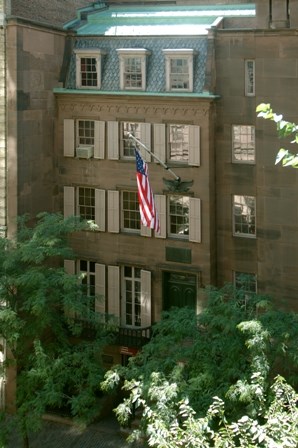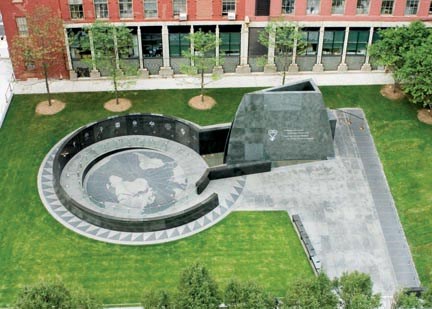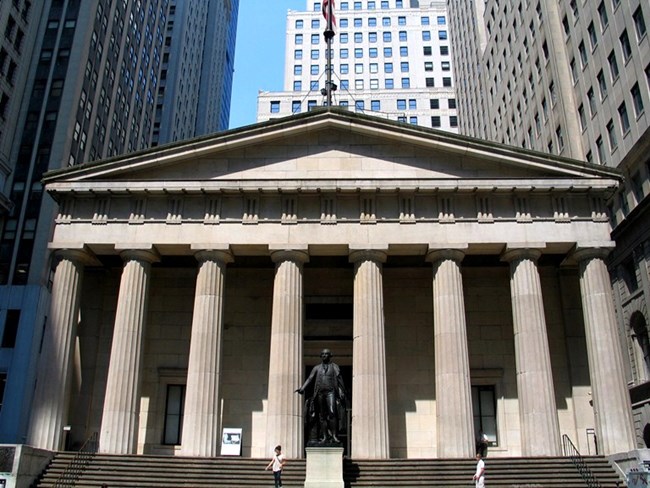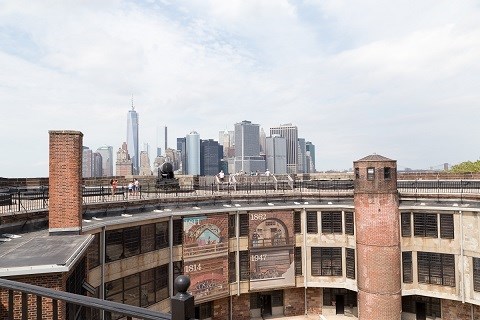Last updated: May 30, 2025
Article
Top Tips for Visiting the Manhattan Sites

NPS
Did you know that there are nine National Park sites within Manhattan? These sites interpret history dating back to the American Revolution through today's civil rights movements for the LGBTQ+ community. Not sure where to start? We've got you covered!
- There is no entrance fee to visit these National Park sites; however, there may be fees associated with onine reservations or public transportation to/from the site. Check the parks' respective websites ahead of time for any associated fees.
- Prior to your visit, we encourage you to check the parks' websites or download the NPS App for available audio/walking tours, NPS Passport stamp locations, and any park alerts/closures that might affect your visit.
- Wear comfy shoes! Some park sites are close to their nearest public transportation stop while others require walking a short distance. Regardless, New York City is a very walkable city so prepare to walk no matter where your trip takes you!
- Prepare for transportation delays! Taking public transportation is a great alternative to driving, but it's not exempt from traffic, above or below ground. Check the MYmta app for any reduced services, planned schedule changes, and other delays, especially during the weekend.
- When it rains, it pours - Check weather forecasts prior to your visit! Conditions can change without much warning and you don't want to be caught off guard (yes, it's cool to use an umbrella in NYC). Bring the necessities to stay comfortable, especially if you need to wait outside awhile for public transportation to arrive.
- When in doubt, ask a Ranger! The information below is reliable yet subject to change. Visit the parks' website for contact information for each site (usually listed at the bottom of the homepage).
Parks are listed north to south.

NPS
Saint Paul's Church National Historic Site
Since 1665, Saint Paul's Church played a vital role in the colonial life of Eastchester, 20 miles north of New York City. Townspeople voted at the nearby Village Green; local militia drilled outside its doors. But the American Revolution changed everything. American, British and Hessian troops tore down the old wooden meetinghouse for firewood and used the unfinished stone chapel as a hospital.
Website: nps.gov/sapa
Operating Hours:
-
Early January - late June: Monday - Friday from 10 am to 5 pm, second Saturday from 12 pm to 4 pm
-
Early July - late December: Tuesday - Saturday from 10 am to 5 pm. Cemetary is open 9 am to 5 pm
Know Before You Go:
- School groups visit the site during Spring and Fall 10 am - 12:30 pm, which limits staff availability and access to the Museum and Church.
- Accessibility: The Museum is ADA accessible; however, the Church is not. Please call ahead of time to ensure the site's portable ramp is in place if you or someone in your group has a disibility and would like to gain access to the Church.
- Visitation during high wind conditions is highly discouraged, due to the possibility of tiles coming loose from the Church roof, and falling limbs and branches from the 100-year-old trees in the Cemetary. Check wind conditions prior to your visit.
Getting Here:
- Public Transportation:
- The 5 train to the last stop, Dyre Street Station
- Bee-Line W55 bus
- Driving: Take Exit 13 off of the I-95 or Exit 7 off of the Hutchinson River Parkway

NPS
Hamilton Grange National Memorial
Merchant’s clerk, Revolutionary War soldier, first Secretary Treasury of the United States: Alexander Hamilton’s life is memorialized at The Grange, the home he built on a country estate in uptown Manhattan. A faithful testament to early American architecture, it stands today as a tribute to its first owner’s many accomplishments.
Website: nps.gov/hagr
Operating Hours:
- Labor Day - Memorial Day: Wednesday - Sunday from 10 am to 4 pm
- Memorial Day - Labor Day: Wednesday - Sunday from 10 am to 5 pm
Know Before You Go:
- The visitor center and bookstore are self-guided. Access to the historic floor is only available on a scheduled tour. Check the Operating Hours & Season website page for tours schedules, since they vary throughout the week.
- To schedule a tour for groups of 10 or more, please email the site at least two weeks prior to your visit. School groups can schedule a visit for Wednesdays, Thursdays, or Fridays.
- The visitor center and historic floor are ADA accessible.
Getting Here:
- Public Transportation:
- The A or C train to 145th Street station
- The 1 train to 145th Street station
- Driving: There is limited street parking near the site.

NPS
General Grant National Memorial
The final resting place of President Ulysses S. Grant and his wife, Julia, is the largest mausoleum in North America. It testifies to a people’s gratitude for the man who ended the bloodiest conflict in American history as Commanding General of the Union Army and then, as President of the United States, strove to heal a nation after a civil war and make rights for all citizens a reality.
Website: nps.gov/gegr
Operating Hours:
- Mausoleum: Wednesday - Sunday from 10 am to 4 pm
- Visitor Center: Wednesday - Sunday from 10 am to 4 pm with an hour closure from 12 pm to 1 pm
Know Before You Go:
- The Mausoleum and Visitor Center are self-guided, though Ranger-led Mausoleum programs are offered on weekends during the summer.
- The Mausoleum is not ADA accessible; however, the Visitor Center is ramp-accessible. Ramp entrance is just north of the Visitor Center in Riverside Park. A self-guided audio tour of the Mausoleum is available on the NPS App, along with a transcript.
- There is hardly any artificial lighting inside the Mausoleum, so visibility inside depends on weather conditions outside. The best days to visit are on clear, sunny days.
- Crypt access may be limited if floor conditions are wet due to rain or snow.
Getting Here:
- Public Transportation:
- The 1 train to 116th or 125th Street station
- The M5 bus to Riverside Dr. & 122nd St
- The M4, M104, or M60+select bus to 120th St & Broadway Ave.
- Driving:
- There is limited parking along Riverside Dr. or in nearby parking garages

NPS
Theodore Roosevelt Birthplace National Historic Site
This is the boyhood home of the first U.S. president to be born in New York City. Raised in a townhouse at 28 E. 20th St., Theodore Roosevelt would grow up to be our 26th President and become immortalized on Mount Rushmore. However, he started life as a sickly yet bright boy who exercised to improve his health and began a lifelong passion for the "strenuous life."
Website: nps.gov/thrb
Operating Hours:
- Wednesday - Sunday from 10 am to 4 pm
Know Before You Go:
- The visitor center and bookstore are self-guided. Access to the historic floors is only available on a scheduled tour. Check the Operating Hours & Season website page for tours schedules, since they vary throughout the week.
- To schedule a tour for groups of 10 or more, please email the site at least two weeks prior to your visit. School groups can schedule a visit for Wednesdays, Thursdays, or Fridays.
- The visitor center and historic floors are ADA accessible.
Getting Here:
- The 4, 5, 6 trains at 14th Street-Union Square station
- The N, Q, R, W trains at 14th Street-Union Square station
- The L train at 14th Street-Union Square station
- The 6 train to 23rd Street station
- The N, R, W trains to 23rd Street station
- The M1, M2, M3, or M5 bus to East 23rd Street

NPS
Stonewall National Monument
Before the 1960s, almost everything about living openly as a lesbian, gay, bisexual, transgender, or queer (LGBTQ+) person was illegal. The Stonewall Uprising on June 28, 1969 is a milestone in the quest for LGBTQ+ civil rights and provided momentum for a movement.
Website: nps.gov/ston
Operating Hours:
- Christopher Park:
- April - October: 9 am to 8 pm
- November - March: 9 am to 5 pm
- Visitor Center:
- Tuesday - Sunday from 10 AM to 4 PM
Know Before You Go:
- Passport stamps are located inside the Visitor Center along with Junior Ranger books.
- Junior Ranger books are also available online.
- Christopher Park and the Visitor Center are ADA accessible.
- Videos and other resources are available at www.nps.gov/ston
Getting Here:
- Public Transportation:
- The 1 train to Christopher Street - Sheridan Square Station
- The M8 or M20 bus via the 7th Avenue bus line
- Driving:
- From Jersey City, take the Holland Tunnel to Ericsson Pl, via exit 3, then take the Avenue of the Americas north to Christopher Street.
- From Brooklyn, take the Manhattan Bridge to Canal Street, then take the Avenue of the Americas north to Christopher Street.

NPS
African Burial Ground National Monument
African Burial Ground is the oldest and largest known excavated burial ground in North America for both free and enslaved Africans. It protects the historic role slavery played in building New York.
Website: nps.gov/afbg
Operating Hours:
- Indoor Visitor Center and Museum:
- Year-round: Tuesday - Saturday from 10 am to 4 pm
- Outdoor Memorial:
- Labor Day - early May: Tuesday - Saturday from 10 am to 4 pm
- Early May - Labor Day: Tuesday - Saturday from 10 am to 5 pm
Know Before You Go:
- Prepare to go through airport-style security.
- You may bring a flower or an offering to leave at a burial mound.
- If you don't have a lot of time to spend with us, you can watch the park film on our website
- Register for a ranger-led tour on recreation.gov
- The artwork in the lobby of the Ted Weiss Federal Building is only accessible if escorted by a park ranger.
Getting Here:
- Public Transportation:
- The 1, 2, 3 trains to Chambers Street station
- The A, C trains to Chambers Street station
- The R train to City Hall station
- The 4, 5, 6 trains to Brooklyn Bridge - City Hall station
- The J, Z trains to Chambers Street station

NPS
Federal Hall National Memorial
Here on Wall Street, George Washington took the oath of office as our first President, and this site was home to the first Congress, Supreme Court, and Executive Branch offices. The current structure, a Customs House, later served as part of the US Sub-Treasury. Now, the building serves as a museum and memorial to our first President and the beginnings of the United States of America.
Website: nps.gov/feha
Operating Hours:
-
Monday - Friday from 10 am to 5 pm
Know Before You Go:
- There is scaffolding around the building but the site is still open!
- The Visitor Center is dedicated to highlighting parks in the Manhattan Sites, as well as other parks in the New York area and around the country.
- Enjoy the 20-minute park film.
- Ask a Park Ranger how to become a Junior Ranger!
Getting Here:
- The 4 or 5 trains to Wall Street station
- The 2 or 3 trains to Wall Street station
- The J or Z trains to Broad Street station
- The 1 train to Rector Street station
- The R train to Rector Street station
- The A or C train to Fulton Street station

NPS
Castle Clinton National Monument
Located at the southern tip of Manhattan Island, Castle Clinton stands where New York City began, and represents not only the city’s growth, but the growth of a nation. Initially intended to prevent a British invasion in 1812, the fortification has transformed over the years to welcome theatergoers, immigrants, sightseers, and now, millions of visitors to New York Harbor.
Website: nps.gov/cacl
Operating Hours:
- Sunday - Saturday from 7:45 am to 5 pm
Know Before You Go:
- Tours of Castle Clinton are offered four times a day, at 10 AM, 12 PM, 2 PM, and 3:30 PM. Tours are 30 minutes long and require some minor walking. All locations in the site are handicap accessible.
- Prepare for rain or shine. Castle Clinton is not an enclosed structure and is exposed to the elements. The fort experiences all types of weather and visitors should check weather conditions before visiting.
- Castle Clinton has a self-guided exhibit room and park store. The park stamp is located within the park store.
Getting Here:
- Public Transportation:
- The 1 train to South Ferry station
- The 4 or 5 trains to Bowling Green
- The R or W trains to Whitehall Street - South Ferry station

NPS
Governors Island National Monument
From 1794 to 1966, the U.S. Army on Governors Island was part of the social, political, and economic tapestry of New York City. Today, the island is a vibrant summer seasonal venue of art, culture, and performance against the backdrop of two centuries of military heritage and the skyline of one of the great cities of the world. The island is open to the public.
Website: nps.gov/gois
Operating Hours:
- While Governors Island is accessible year round, the Governors Island National Monument is a seasonal destination. Keep an eye on our website and social media pages for updates for park opening and closing.
Know Before You Go:
- Wear your walking shoes! Governors Island is a 172 acre island, and the National Monument is 22 acres. Wear comfortable shoes, because you will be walking a lot! Whether on a Park Ranger led tour, or on a self guided walk, you are sure to hit your daily step count.
Getting Here:
- Governors Island is only accessible by ferry. There is daily service from the Battery Maritime Building in Manhattan. For service from other parts of the city, and for ferry schedules, visit Ferry | Governors Island (en-US) (govisland.com).
Tags
- african burial ground national monument
- castle clinton national monument
- federal hall national memorial
- general grant national memorial
- governors island national monument
- hamilton grange national memorial
- national parks of new york harbor
- saint paul's church national historic site
- stonewall national monument
- theodore roosevelt birthplace national historic site
- plan like a park ranger
- manhattan sites
- top tips
